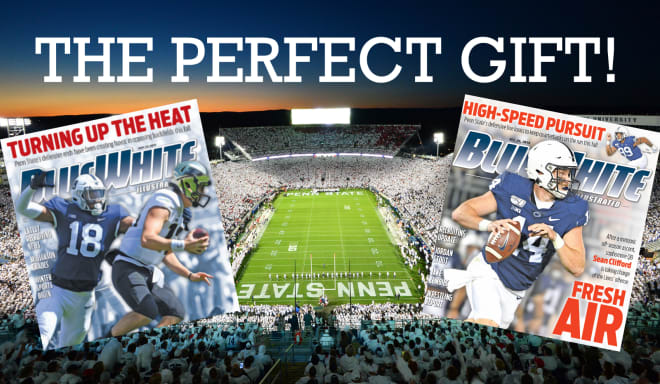The following column appears in the latest edition of Blue White Illustrated's magazine, which has printed and shipped to our print subscribers and is on newsstands throughout Pennsylvania.
Sept. 30, 2019, should prove to be a watershed moment in the world of college athletics.
By now, you’ve probably heard of California’s Senate Bill 206, also known as the Fair Pay for Play Act, which was signed into law that day by Gov. Gavin Newsom. The law forces colleges and universities in California to allow their scholarship athletes to make money in different ways. That includes selling their name, image and likeness to any company that may have interest. It’s been a long time coming now, and whether you’re OK with a state government forcing this change is a completely different debate, but there’s one thing we know for sure: The NCAA is on the clock.
While the law has already been signed, it won’t go into effect until Jan. 1, 2023. There’s a reason for that. California is giving the NCAA roughly three years to change the way it does business or get out of the way. Considering that the organization brings in over $1 billion a year, no one is going anywhere.
President Mark Emmert is fully aware of this, too. In fact, it took the NCAA just a month to soften its tone on the subject. Following an internal review, the NCAA stated publicly on Oct. 29 that it was open to the idea of allowing college athletes “the opportunity to benefit from the use of their name, image and likeness in a manner consistent with the collegiate model.” That’s after years and years of no budging at all. That’s also far from an endorsement of California’s law, but it does suggest that some sort of change is only a matter of time.
But one thing that I don’t expect to see right from the start is schools directly paying their players. That could come down the road, but in order to get this started in a few years, expect the NCAA to focus on outside avenues for its student-athletes to make money on the side. With time, however, that could become an issue in itself. We all know that football players like Micah Parsons and Pat Freiermuth will have plenty of local and regional opportunities, but that won’t be the case with everyone, including those on the same team. Not to mention, Title IX could have a real impact on this model holding up on its own. At the same time, life isn’t fair and business isn’t fair. If you earn, good for you, so I see both sides of this argument.
I also don’t think we’re going to see agents in college football anytime soon. California’s law would actually allow it, but once this does finally roll out, I think many will realize that third-party agencies aren’t a good thing for college athletics. The majority of 18-year-olds aren’t ready to be brought into that world yet. I know it happens in other sports, but take it from someone who gets to know these players before they ever suit up in Beaver Stadium, many of these young men don’t understand the pros and cons that come with that. Not all agents are crooks, but you can also argue that not all agents care about the player over profits.
Instead, don’t be surprised if schools are forced to start new departments to oversee these commercial opportunities. So, for example, if a State College business wants to pay Parsons or Freiermuth a few hundred dollars to do an appearance or an advertisement, they’ll be contacting Penn State’s new player representation department and not a third-party agent. There are some pros and cons that come with that model, too, but it’s a safer way to manage things. Major athletic departments can afford it, and it helps keep their student-athletes focused on what matters most.
One last thing I’m curious to see is how this change could potentially impact the transfer portal. If you think it’s crazy now, just wait until a top player at a smaller program decides he wants to play at a Power Five school. Sure, we’re already seeing that, but the focus in a few years may no longer be about challenging yourself against the nation’s best. Can you imagine if a player like current Buffalo Bills quarterback Josh Allen, who made a name for himself at Wyoming, had been given an opportunity to transfer immediately to a school like USC? Oh, and not only can he play right away, but he can also do as many advertisements as he wants in one of the nation’s biggest media markets?
The opportunities for NFL prospects at smaller schools to go elsewhere could to be too good to pass up. I love Power Five football, but I also respect what schools in the Mid-American Conference and Mountain West, among others, have been able to accomplish over the years. I’d hate to see them be put at a major disadvantage after developing a player.
The people in charge of college athletics still have a few years to figure this out, but it’s clear that change is coming and it’s coming fast. It’s also clear that the NCAA doesn’t have a choice anymore. It’s time to allow its student-athletes to get in on the action.
*******
• Talk about this article inside The Lions Den
• Watch our videos and subscribe to our YouTube channel
• Learn more about our print and digital publication, Blue-White Illustrated
• Follow us on Twitter: @BWIonRivals, @NateBauerBWI, @RivalsSnyder, @DavidEckert98
• Like us on Facebook

What else is in the latest issue of Blue White Illustrated's magazine? Let's take a closer look at some of the feature stories, news and notes, here!
THE RUNDOWN:
FOOTBALL - We've got yet another issue packed with football as the Nittany Lions wrap up their 2019 regular season. Feature stories in this issue include: Penn State's offensive line and the trio of veterans that have helped mold the unit into what it is today, Sean Clifford's emergence at quarterback in the face of uncertain expectations to start the season, tight end Pat Freiermuth's big impact on the Nittany Lion offense, and more.
PHIL'S CORNER - With a specific set of improvements for Penn State moving forward, the Nittany Lions could become one of the best teams in college football, BWI publisher Phil Grosz writes. And really, given the Nittany Lions' excellent 10-2 campaign in 2019, they'll be necessary to take a next step in the coming year.
RECRUITING - As always, BWI recruiting analyst Ryan Snyder has your Penn State football recruiting fix. In this issue, he checks in for a full one-on-one interview with four-star offensive lineman verbal commitment Jimmy Christ. Other features include Up Close and Personals with Tyler Warren and Nick Dawkins.
HOOPS - BWI men's basketball beat writer Nate Bauer takes a look at the variety Penn State has shown early this season in its ability to score, and how that could shape the Nittany Lions' chances at success through the rest of the 2019-20 season.
WRESTLING - BWI's Jim Carlson has you covered as the Nittany Lions wrestlers begin the defense of their 2019 national championship
And these are just a few of the many stories and features that come with every edition of Blue White Illustrated's magazine, including Varsity Views notebook, Scorecard, The Last Word, and more!

